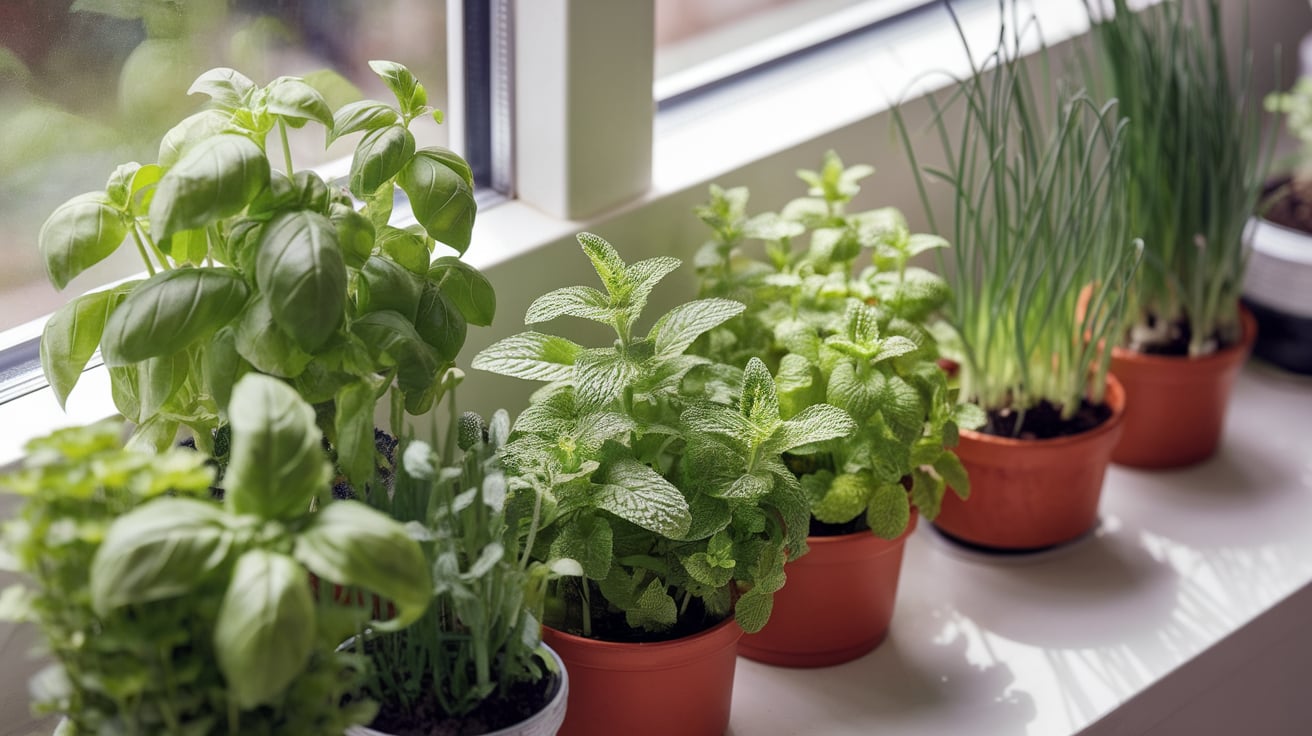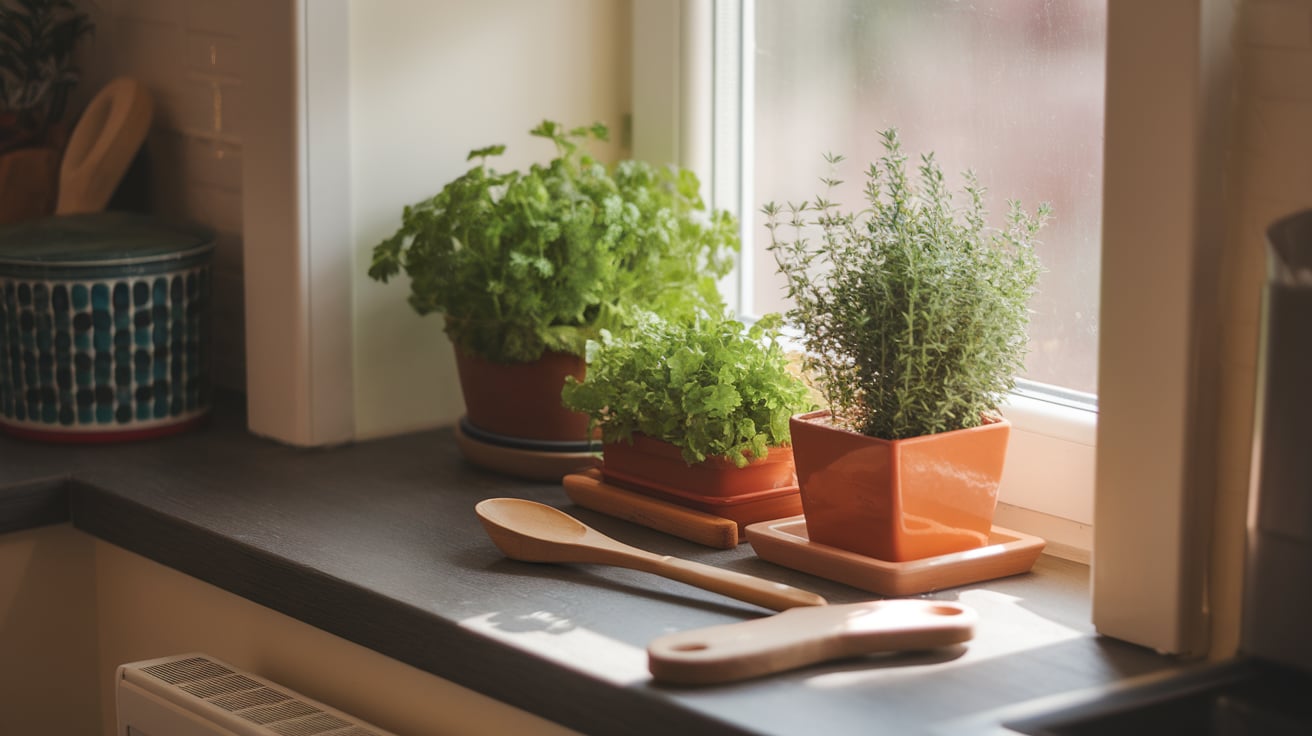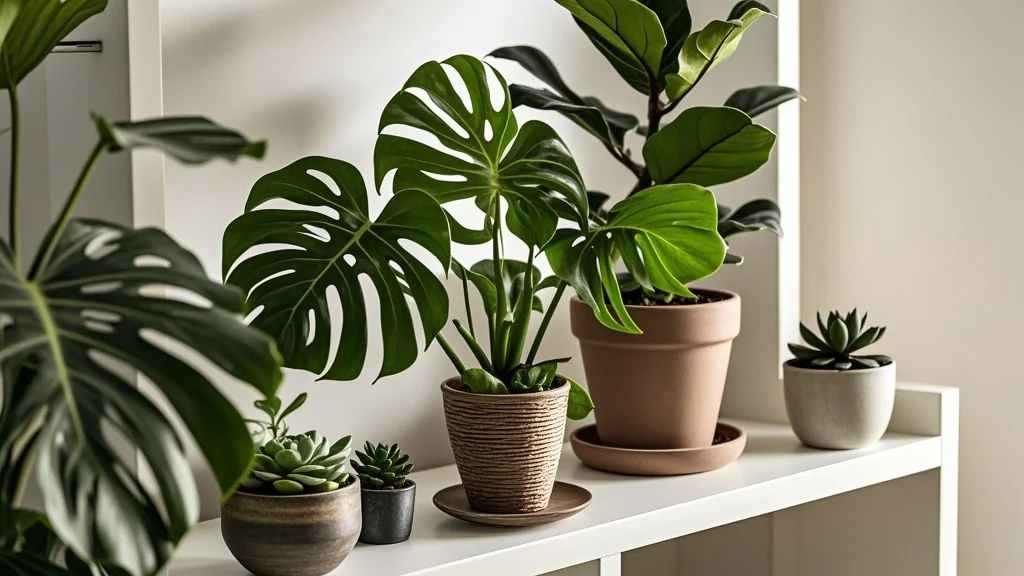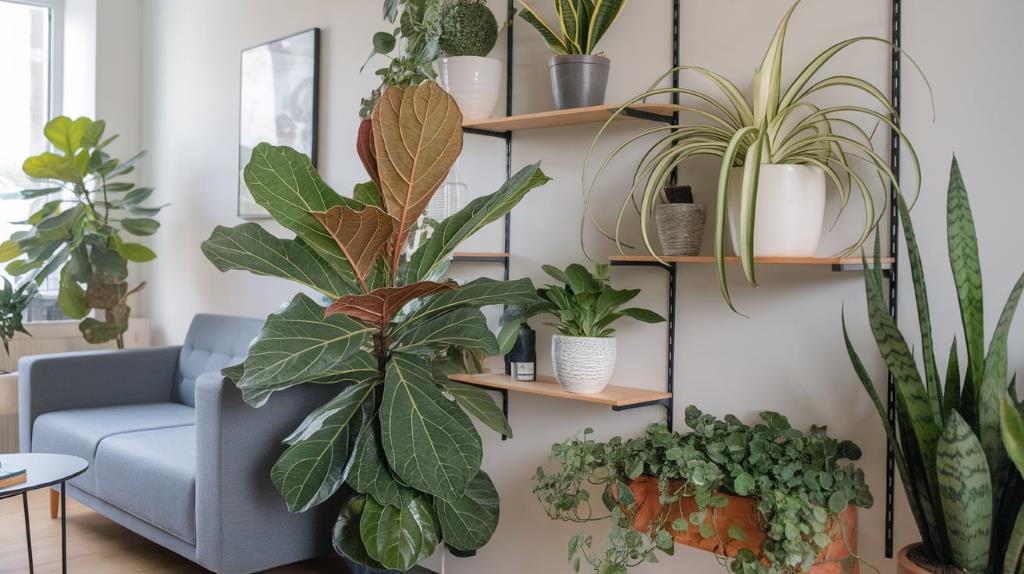Living in a small apartment doesn’t mean you have to sacrifice the joy of growing your own fresh herbs. In fact, herbs are among the most apartment-friendly plants you can cultivate, requiring minimal space while delivering maximum flavor. Whether you have a tiny windowsill, a small balcony, or just a spare corner in your kitchen, you can create a thriving herb garden that enhances your cooking and brings a touch of nature into your urban dwelling.
Fresh herbs elevate everyday dishes with vibrant flavors that dried alternatives simply can’t match. Beyond culinary benefits, growing herbs indoors improves air quality, adds visual appeal to your space, and provides the satisfaction of nurturing living plants—all valuable benefits for city dwellers in compact living situations.
This guide will walk you through everything you need to know about establishing and maintaining a successful herb garden in your small apartment, from selecting the right varieties to harvesting techniques that promote continued growth.
Contents
- 1 Choosing the Right Herbs for Small Spaces
- 2 Essential Supplies for Your Indoor Herb Garden
- 3 Setting Up Your Apartment Herb Garden
- 4 Daily Care and Maintenance
- 5 Common Challenges and Solutions
- 6 Creative Space-Saving Solutions
- 7 Harvesting and Using Your Herbs
- 8 Seasonal Considerations
- 9 Expanding Your Herb Garden
- 10 Conclusion
Choosing the Right Herbs for Small Spaces

Not all herbs are created equal when it comes to indoor growing. Some thrive in containers and limited light conditions, while others struggle without expansive outdoor space. Here are the best herbs for apartment cultivation:
Easy-to-Grow Herbs for Beginners
- Basil: A kitchen staple that grows quickly in warm conditions with moderate light. Perfect for windowsills that receive at least 4-6 hours of sunlight.
- Mint: Nearly indestructible and vigorous—sometimes too vigorous! Always grow mint in its own container to prevent it from overtaking other herbs.
- Chives: These hardy perennials require minimal care and regrow quickly after cutting. Their mild onion flavor enhances countless dishes.
- Parsley: Tolerates lower light conditions better than many herbs and provides abundant leaves for harvesting.
- Cilantro: Fast-growing and perfect for frequent harvests, though it does prefer cooler temperatures than some other herbs.
Herbs That Thrive in Containers
- Rosemary: This woody perennial adapts well to container life and doesn’t mind if you occasionally forget to water.
- Thyme: Low-growing with minimal space requirements, thyme varieties offer different flavor profiles for culinary experimentation.
- Oregano: Drought-tolerant and compact, oregano brings Mediterranean flavor to your kitchen with minimal fuss.
- Sage: With beautiful, velvety leaves, sage adds both culinary value and visual interest to your herb collection.
Herbs to Avoid in Small Spaces
- Dill: Grows tall quickly and doesn’t transplant well, making it challenging for indoor environments.
- Fennel: Develops a deep taproot and requires more space than most apartment setups can provide.
- Lemongrass: While aromatic and useful, it grows quite large for typical indoor containers.
Essential Supplies for Your Indoor Herb Garden
Creating a successful apartment herb garden requires some basic equipment, but you don’t need to invest heavily to get started:
Containers and Potting Options
- Traditional pots: Terracotta pots are excellent for herbs as they allow soil to breathe, though plastic containers work well too. Ensure all containers have drainage holes.
- Window boxes: Maximize windowsill space with rectangular planters that can house multiple herbs.
- Vertical planters: Wall-mounted systems or hanging options make use of vertical space—perfect for apartments with limited floor area.
- Repurposed containers: Mason jars, tea tins, or even old mugs can become charming herb planters with proper drainage added.
- Self-watering containers: These can be lifesavers for forgetful gardeners or during busy periods when regular watering might be missed.
Soil and Nutrients
- Potting mix: Use a high-quality, well-draining potting mix specifically formulated for containers. Regular garden soil is too dense for potted herbs.
- Organic matter: Adding compost improves soil structure and provides slow-release nutrients.
- Fertilizer: A balanced, water-soluble fertilizer diluted to half-strength works well for most herbs. Apply monthly during growing season.
- Perlite or vermiculite: Adding these to your potting mix improves drainage—crucial for preventing root rot in containers.
Lighting Solutions
- Natural light: South-facing windows provide ideal conditions for most herbs. East or west exposures can also work well.
- Supplemental lighting: For apartments with limited natural light, consider:
- LED grow lights: Energy-efficient and produce minimal heat
- Full-spectrum fluorescent bulbs: Affordable and effective for herbs
- Adjustable desk lamps with grow bulbs: Perfect for small setups
- Light duration: Most herbs need 6-8 hours of light daily. In winter, you may need to extend artificial lighting to compensate for shorter days.
Setting Up Your Apartment Herb Garden
With supplies gathered, it’s time to establish your indoor herb oasis:
Location Considerations
- Kitchen proximity: Keeping herbs near your cooking area increases the likelihood you’ll use them regularly.
- Temperature stability: Avoid placing herbs near heating vents, air conditioners, or drafty windows.
- Humidity levels: Most herbs prefer moderate humidity. Bathrooms with good light can be surprisingly effective growing spaces.
- Air circulation: Good airflow prevents mold and fungal issues common in indoor environments.
Planting Techniques
- Prepare containers: Ensure drainage holes exist; add a layer of small stones or broken pottery at the bottom if needed.
- Fill with soil: Leave about an inch of space below the rim to prevent overflow when watering.
- Planting depth: Most herb seeds should be planted at a depth equal to twice their diameter. For seedlings, plant at the same depth they were growing previously.
- Spacing: In shared containers, provide adequate space between different herbs—generally 4-6 inches for most varieties.
- Initial watering: Water thoroughly after planting until moisture comes through drainage holes, then allow the top inch of soil to dry before watering again.
Organizing Multiple Herbs
- Group by water needs: Place herbs with similar watering requirements together. Mediterranean herbs like rosemary, thyme, and sage prefer drier conditions, while basil and mint like consistent moisture.
- Consider height: Position taller herbs where they won’t shade smaller varieties.
- Companion planting: Some herbs grow better together. Basil and parsley make good companions, while mint should always be isolated.
- Rotation system: For limited space, consider a rotation system where you grow different herbs seasonally rather than all at once.
Daily Care and Maintenance
Consistent care is the key to a thriving indoor herb garden:
Watering Practices
- Check soil moisture: Insert your finger about an inch into the soil—if it feels dry, it’s time to water.
- Bottom watering: Place pots in a shallow tray of water for 30 minutes, allowing soil to absorb moisture from below. This encourages deeper root growth.
- Morning watering: Watering early in the day gives leaves time to dry, reducing disease risk.
- Avoid overwatering: More herbs die from too much water than too little. Yellow leaves often indicate overwatering.
Light Management
- Rotate containers: Turn pots a quarter turn weekly to ensure even growth, as plants naturally lean toward light sources.
- Seasonal adjustments: Herbs need more water when receiving intense light and less during darker winter months.
- Light duration: If using grow lights, maintain a consistent schedule—12-16 hours on, 8-12 hours off mimics natural conditions.
Pruning and Harvesting
- Regular harvesting: Frequent, light harvesting encourages bushier growth and prevents herbs from becoming leggy.
- Pruning technique: Use clean scissors or shears to make cuts just above a leaf node or set of leaves.
- Flower removal: Pinch off flower buds as they appear (unless you’re saving seeds) to extend the plant’s productive life.
- Succession harvesting: Take outer leaves first, allowing inner growth to continue developing.
Common Challenges and Solutions
Even experienced gardeners face obstacles with indoor herbs. Here’s how to troubleshoot common issues:
Pest Management
- Aphids: Treat with a gentle spray of water mixed with a few drops of dish soap.
- Spider mites: Increase humidity and treat with neem oil or insecticidal soap.
- Fungus gnats: Allow soil to dry more between waterings and consider adding a layer of sand on top of the soil.
- Prevention: Regularly inspect new plants before bringing them home, and isolate any showing signs of infestation.
Disease Prevention
- Powdery mildew: Improve air circulation and avoid wetting leaves when watering.
- Root rot: Ensure proper drainage and let soil dry appropriately between waterings.
- Leaf spot: Remove affected leaves promptly and avoid overhead watering.
Environmental Adjustments
- Winter care: Move plants away from cold windows at night and consider supplemental lighting during shorter days.
- Summer heat: Protect herbs from intense afternoon sun that can scorch leaves, especially on south-facing windowsills.
- Humidity boosting: Group plants together or place containers on trays filled with pebbles and water to increase humidity.
Creative Space-Saving Solutions
When space is truly at a premium, get creative with these innovative approaches:
Vertical Growing Systems
- Wall-mounted planters: Utilize wall space with pocket planters, magnetic containers, or repurposed shoe organizers.
- Tiered stands: Multi-level plant stands maximize vertical space while keeping herbs accessible.
- Hanging planters: Suspend herbs from ceiling hooks or curtain rods in front of windows.
- Window shelving: Install narrow shelves directly in window frames to capture maximum light.
Multi-Functional Herb Gardens
- Herb centerpieces: Create living table decorations that serve both aesthetic and culinary purposes.
- Kitchen backsplash gardens: Mount small containers on unused backsplash space.
- Bookshelf integration: Dedicate a shelf of your bookcase to herbs, using grow lights if natural light is insufficient.
- Under-cabinet systems: Install grow lights beneath kitchen cabinets to create growing space on countertops.
Miniature and Micro Gardens
- Microgreens: Grow herb seedlings in shallow trays, harvesting when just a few inches tall for intense flavor.
- Single-stem growing: Focus on growing individual stems in tiny containers like shot glasses or test tubes.
- Bonsai herb techniques: Prune herbs like rosemary or sage to maintain miniature forms while still harvesting leaves.
Harvesting and Using Your Herbs
The reward for your efforts comes in the form of fresh, flavorful herbs ready for culinary use:
Harvesting Best Practices
- Timing: Harvest in the morning after dew has dried but before the day’s heat intensifies oils.
- Quantity: Never remove more than one-third of the plant at once to ensure continued growth.
- Technique: Use sharp scissors to make clean cuts rather than tearing, which can damage plants.
- Seasonal considerations: Harvest more aggressively before winter when growth naturally slows.
Preserving Excess Herbs
- Freezing: Chop herbs and freeze in ice cube trays with water or olive oil for convenient cooking portions.
- Drying: Hang small bundles in a warm, dry location with good air circulation.
- Herb butters: Blend chopped herbs into softened butter, then refrigerate or freeze in logs.
- Herb salts: Mix finely chopped herbs with coarse salt for flavored finishing salts.
Culinary Applications
- Fresh herb combinations: Create signature herb blends for different cuisines—Italian (basil, oregano, parsley), French (tarragon, chervil, thyme), or Mexican (cilantro, oregano, epazote).
- Infusions: Make herb-infused oils, vinegars, or simple syrups for cooking and cocktails.
- Herb finishing: Add fresh herbs at the end of cooking for maximum flavor impact.
- Beyond cooking: Use herbs in teas, cocktails, natural home fragrances, or homemade beauty products.
Seasonal Considerations
Adapt your herb gardening approach throughout the year:
Winter Care
- Reduced watering: Most herbs enter a semi-dormant state in winter and require less frequent watering.
- Supplemental lighting: Consider grow lights during short winter days, especially in northern locations.
- Temperature management: Keep herbs away from cold drafts and heating vents that can dry them out.
- Focus herbs: Rosemary, thyme, and sage often perform better in winter than tender herbs like basil.
Summer Adaptations
- Increased watering: Check soil moisture daily during hot weather.
- Heat protection: Move herbs away from windows during intense afternoon sun or use sheer curtains to filter light.
- Outdoor opportunities: Consider temporarily relocating herbs to balconies or fire escapes during warm months.
- Vacation planning: Set up self-watering systems or group plants in bathtub with shallow water before extended absences.
Expanding Your Herb Garden
As your confidence grows, consider these ways to develop your herb gardening skills:
Propagation Techniques
- Stem cuttings: Many herbs like mint, basil, and rosemary readily root in water or moist soil.
- Division: Split mature plants like chives or oregano to create new plants.
- Seed saving: Allow a portion of your herbs to flower and collect seeds for future planting.
- Layering: Bend flexible stems to soil level and secure until roots form at the contact point.
Experimenting with Unusual Herbs
- Lemon verbena: Intensely aromatic with versatile culinary applications.
- Shiso/Perilla: Japanese herb with complex flavor perfect for Asian cuisine.
- Mexican tarragon: Anise-flavored herb that grows well indoors.
- Stevia: Natural sweetener that can be grown in containers.
Creating Themed Gardens
- Tea garden: Mint, chamomile, lemon balm, and other herbs for brewing.
- Pizza garden: Oregano, basil, thyme, and rosemary.
- Cocktail garden: Mint, basil, rosemary, and thyme for creative drinks.
- Medicinal garden: Echinacea, chamomile, lavender, and other traditional healing herbs.
Conclusion

Growing herbs in a small apartment is not just possible—it’s a rewarding practice that connects urban dwellers with the natural cycles of growth and harvest. With minimal investment and space, you can establish a productive herb garden that enhances your cooking, purifies your air, and brings the satisfaction of nurturing living plants.
The key to success lies in selecting appropriate varieties, providing adequate light, maintaining proper watering habits, and harvesting regularly to encourage continued growth. By adapting these principles to your specific living situation—whether you have a sunny windowsill or need to rely on grow lights—you can enjoy fresh herbs year-round, regardless of your apartment’s size.
As your confidence grows, so too can your herb collection, expanding into more varieties, propagation experiments, and creative growing solutions. The journey from a single pot of basil to a diverse indoor herb garden is one of continuous learning and adaptation—much like the herbs themselves, which have evolved to thrive in diverse conditions.
So clear a small space on your windowsill, gather a few pots and seeds, and begin your apartment herb gardening adventure. The fresh flavors, aromatic presence, and connection to growing things will transform both your cooking and your living space in ways that extend far beyond the modest space your herbs occupy.









